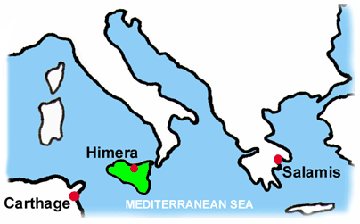Victory at Himera
Xerxes
I, king of Persia, planned for years his campaign against the Greek
city-states to avenge their defeat of his father, Darius I, at Marathon
in 490 BC. Part of his preparation included enlisting Carthage, on the
north coast of Africa, to invade Sicily, thereby pinning down the forces
of Syracuse and Agrigento and preventing their coming to the defense
of their fellow Greeks on the mainland.
 In 480 BC Xerxes launched his long-awaited attack against the mainland
Greeks. At the same time his Carthaginian allies began their invasion
of Sicily. At Himera, on the north coast of Sicily, the Carthaginians
met devastating defeat at the hands of Syracuse, aided by the forces
of Agrigento. Thereafter, with the external threat repulsed, Gelon,
Tyrant of Syracuse, consolidated his power throughout most of Greek
Sicily.
In 480 BC Xerxes launched his long-awaited attack against the mainland
Greeks. At the same time his Carthaginian allies began their invasion
of Sicily. At Himera, on the north coast of Sicily, the Carthaginians
met devastating defeat at the hands of Syracuse, aided by the forces
of Agrigento. Thereafter, with the external threat repulsed, Gelon,
Tyrant of Syracuse, consolidated his power throughout most of Greek
Sicily.
Xerxes fared no better than his Carthaginian allies. After a series
of Persian victories in preliminary naval engagements and a costly victory
over the Spartans on land at Thermopylae, the Persian and Athenian fleets
met each other at Salamis in one of history's most celebrated sea battles.
The result was punishing defeat for the Persians, who lost half their
entire fleet. The united Greek armies followed up on that triumph with
land victories at Plataea and Mycale, paving the way for a Greek cultural
heritage in Europe rather than a Persian one.
©
1999 C. I. Gable